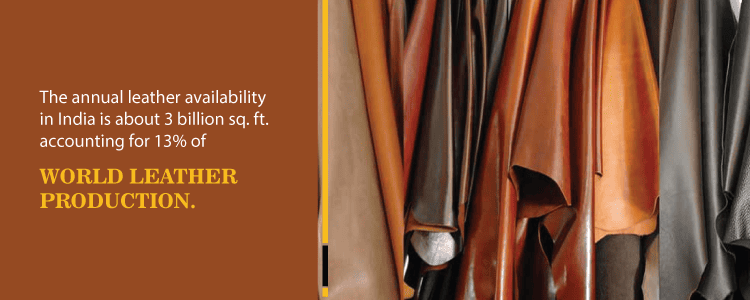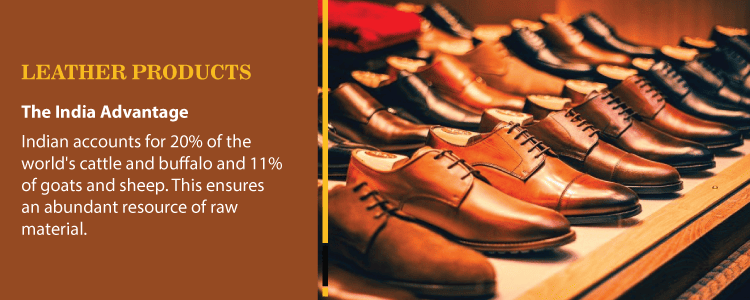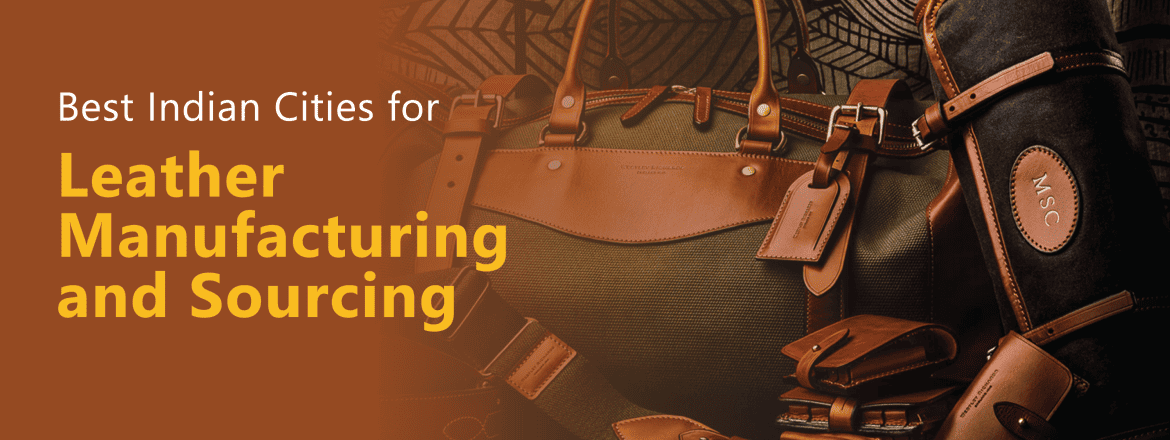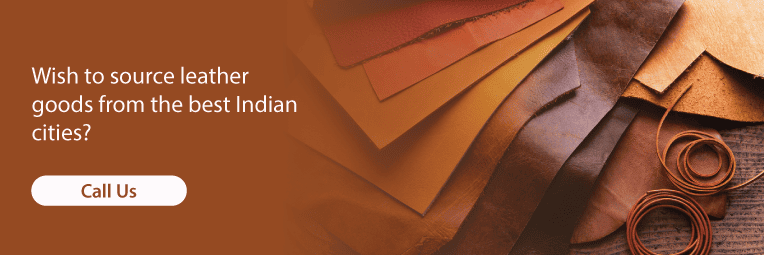The Best Indian Cities for Manufacturing and Sourcing Leather Products in 2025
India is ranked in the top 10 leather-exporting countries making leather one of the primary industries that brings foreign exchange into the country. The country has a strong regional stance when it comes to leather goods bound to grow in global prominence. The entire value chain, ranging from high-quality tanned leather to ready-to-wear fashion garments, combines modern technologies with traditional arts, which epitomizes the Indian culture for civilizations.
This industry allows for the employment of approximately 4.42 million people, targeting women and championing 30% of the workforce. The ideals of equality were fulfilled. The second exporter for leather garments and the third-largest exporter of saddlery and harnesses, while ranking 4th for all goods leather makes India not only famous for its articles of clothing such as shoes, bags, and a diverse array of luxury items, but also underlines its mark for over 13% of the world’s leather production, making it a name in the industry globally. India’s exports of leather and leather goods for the financial year 2023 stood at $ 5.26 billion, which further confirms the sector’s demand on a global level.
Why India Leads the Leather Sourcing Process?
The process of sourcing leather is complex and subdivided into several categories, starting from acquiring raw animal skins to producing finished leather. It starts with the curing and soaking process, which helps in preserving and cleaning the hides. Painting, liming, and fleshing help in removing hair and tissue. Hides are then subjected to chemical processes such as de-liming, bating, pickling, and degreasing, among other things. Tanning is done through either minerals, vegetables, or oils.
From there, the leather is worked on with splitting, shaving, neutralizing, dyeing, slaking, and fat liquoring so that the appropriate thickness, color, and texture are achieved. Additional activities like slamming, setting out, drying, staking, dry drumming, buffing, and brushing smoothen and soften the leather. Finally, the alterations from raw leather to ready-for-sale leather are completed by changing it to a desired color, making it durable, checking for quality, and grading and measuring it.

Best Indian Cities for Leather Products Sourcing
The production of leather and footwear within the country occurs in a number of important cities that contribute some measure to the greater output of the industry:
- Ambur—All over the globe Ambur, a city of Tamil Nadu, is extensively known as a top exporter of leather products and one of the biggest surface leather products with its abundant leather tanning factories.
- Kolkata—It is also known to have the largest leather industrial park in Asia, Kolkata Leather Complex, which has numerous tanneries and leather goods manufacturing units.
- Kanpur—It is reputed to host leather production. It is one of the biggest leather manufacturers of India .It is the largest center for buffalo-based leather in India, contributing to the overall Indian leather and leather goods export.
- Agra – Agra is famous for its affordable leather products and shoe making, with well-crafted shoes made for men and women. The shoes made for women are embellished with beads, fabric and embroidery to make designer footwear and chappals like Moseri. Agra is a major leather product supplier in India.
- Noida – Noida is known for its leather garment manufacturers and traders. The planned leather merchandise manufacturing park in Noida, indicates a future focus on leather production and related logistics, potentially making it a major hub in western Uttar Pradesh.
- Saharanpur – It is famous particularly for leather goods like shoes, bags, and belts. It’s a center for leather manufacturers and artisans.
- Mumbai – Leather goods production is also an important economic activity of this city. Dharavi area is a major contributor to India’s overall leather production. It’s known for producing a wide variety of leather goods and accessories. The industry is supported by access to raw materials and employs a large number of skilled artisans,
- Jalandhar – It is well known for its production firms that fuel the leather economy in footwear.The Council for Leather exports has established a Common Facility Centre (CFC) in Jalandhar to uplift the industry,in areas like market information, government schemes and marketing.
- Bengaluru – In South India, it is famous for its role in leather production.This involves several key stages, from raw hide processing to the finished goods. Several companies in Bangalore are involved in manufacturing, specialized in goods like garments and accessories.
- Dewas – It is a newcomer in the domain of leatherworks from Madhya Pradesh. It is a significant hub for leather manufacturing in India, known for the Tata international’s tannery. Established in 1975, promotes organized international leather trade and wholesale leather supplies which supports rural development. It’s one of India’s largest tannery and a key producer of footwear and fashion leather.

Moreover, there are some other cities in Haryana, like Ambala, Gurgaon, and Faridabad, that now contribute some products to the leather city. In the south of India, we have Kozhikode and Ernakulum/Cochin in Kerala, which do some work for producing leather. These cities make India’s leather and footwear industry an epitome that stimulates both domestic market consumption and international trades. The garments export industry’s contribution to the leather industry’s export share reflects the importance of it in India’s leather industry while also maintaining the country’s position as the second largest exporter of leather goods in India.
India has many suppliers of leather goods, and Inductus Global is one among them. They deal in wholesale leather goods such as bags, wallets, belts, shoes, and other accessories. The company is famous for employing skilled craftsmen and sewing eco-friendly bespoke solutions to business requirements. Inductus Global is a dependable supplier of leather products for retailers and brands because they uphold sustainability along with international eco-friendly standards, ensuring their fashion products are ethically sourced.
The major export targets for the export of leather are the United States and the United Kingdom. The total export value of leather and leather products from India during FY25 (April-December) is estimated at Rs.1,26,902 crore, or 1.51 billion dollars. The largest share is leather footwear, including its parts and non-leather ones, with a value of 598.58 million dollars, which is 51.9% of total exports.
India is exporting leather and leather products to more than 50 countries, out of which 15 countries that include the USA, Germany, the UK, etc. accounted for 78.77 percent of total exports worth US$ 2.87 billion in FY25 (April–December).
Indian Policies Around Leather Industry
In India, the leather industry is one of the most important for the economy, with enormous export potential and a large domestic market. It is a steady generator of foreign exchange earnings and jobs. The Indian government has identified the sector as a priority one for development, with the aim of helping the country to expand its exports and create jobs. Importantly, India manufactures an extensive array of leather goods, footwear, travel items, accessories, garments, and saddlery.
The Indian government has actively facilitated the development of the leather industry through initiatives such as the Indian Leather Development Programme (ILDP) and Make in India. These efforts mainly include
- financial assistance
- infrastructure development
- support for exports
So, now the sector can grow and improve its competitiveness in the international market. As a result, India’s leather exports have been on a steady rise, strengthened with much more dominance in the global market.
India’s positioning, especially its near markets in Europe, the Middle East, and Southeast Asia, significantly bolsters delivery timelines and logistics costs. Participation in international trade fairs has elevated visibility across the globe and, more importantly, invites partnerships. Continuing to invest in quality, sustainability, and innovation, India will strengthen its position within the global leather industry.
In keeping with the heightened global emphasis on environmental responsibility, India’s leather industry has taken giant strides toward pan-sustainable practices. More brands are using ethically sourced leather and implementing environmentally friendly tanning processes that reduce chemicals and water consumption. The humane treatment of livestock comes along with improved worker welfare. Manufacturers, in addition, are harnessing even more advanced technologies like:
- Chromium Salts
- Zero waste discharge technologies
- Vegetable tanning
These are used to improve efficiencies, reduce waste, and bring in a circular economy that would be more in line with international sustainability standards. Among such initiatives was the Indian Footwear and Leather Development Program (IFLDP), which is also known to promote green technologies, infrastructure, and skills towards the development of this sector within the parameters of international environmental standards.
Conclusion
The leather industry in India showcases a leading instance of where modernity, tradition, and eco-friendliness have amalgamated successfully. High-tech machinery and tools are brought into the processing of this very ancient business. Because of its historic past, unrelenting quality standards, and focus on overall development, this sector will not only maintain its major role in the economy regarding best global practices but also rise to play an increasingly important international role.
In 2025, Kanpur, Chennai, and Kolkata will still be leading Indian cities for the production and sourcing of leather goods, alongside newer contributing cities such as Noida. The “Leather City of India” Kanpur will still be a leading center in India for leather goods and tanning. And Kolkata will remain a significant center for the sourcing as well as production of leather goods, especially for the apparel segment, because of its well-established infrastructure









